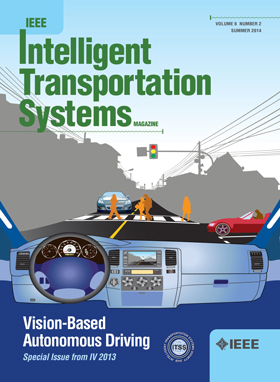Improved Crowd Dynamics Analysis Considering Physical Contact Force and Panic Emotional Propagation
IF 7.9
1区 工程技术
Q1 ENGINEERING, CIVIL
IEEE Transactions on Intelligent Transportation Systems
Pub Date : 2024-12-17
DOI:10.1109/TITS.2024.3512501
引用次数: 0
Abstract
Panic behaviors in a pedestrian flow often lead to a state of chaos or disorder among the pedestrian crowd, resulting in a crowd accident with high possibility. To investigate the panic pedestrian dynamics and further prevent serious crowd accidents, simulation based on dynamics modeling and accident video data is a popular solution to date. Thereby, it is challenging but significant to improve the crowd dynamics model more consistent with the ground truth of real pedestrian movement scenarios, with consideration of both physical contact force and panic emotional propagation in a crowd. Therefore, this study proposed an extended social force model (ESFM) by applying the physical contact-force estimation during pedestrian collision based on non-smooth contact dynamics. Subsequently, the ESFM was integrated with an improved panic propagation model (IPPM) considering obstacle and promotion factors. Finally, taking the crowd panic accident happened in Nepal in 2015 as an experiment case, the simulation of panic crowd dynamics was conducted within Anylogic software. Four cases of SFM, ESFM, SFM+IPPM, and ESFM+IPPM were compared quantitatively and graphically. The experimental results showed that the pedestrian distribution obtained from the proposed ESFM+IPPM was the closest to the ground truth during the panic response period, with 28.8% lower of Hausdorff distance than the original SFM, and 21.6% lower the well-known BHSFM, respectively. This approach can help improve the panic crowd modeling and pedestrian distribution prediction in real scenarios.求助全文
约1分钟内获得全文
求助全文
来源期刊

IEEE Transactions on Intelligent Transportation Systems
工程技术-工程:电子与电气
CiteScore
14.80
自引率
12.90%
发文量
1872
审稿时长
7.5 months
期刊介绍:
The theoretical, experimental and operational aspects of electrical and electronics engineering and information technologies as applied to Intelligent Transportation Systems (ITS). Intelligent Transportation Systems are defined as those systems utilizing synergistic technologies and systems engineering concepts to develop and improve transportation systems of all kinds. The scope of this interdisciplinary activity includes the promotion, consolidation and coordination of ITS technical activities among IEEE entities, and providing a focus for cooperative activities, both internally and externally.
 求助内容:
求助内容: 应助结果提醒方式:
应助结果提醒方式:


